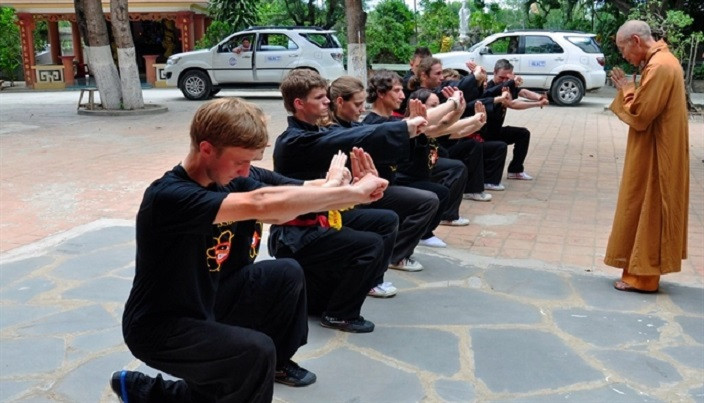
Bình Định martial arts have been handed down since the 15th century. Military generals under the Tây Sơn reign (1778-1802) developed them to train soldiers to fight foreign invaders. Generations later, they are still performed and preserved by students of all ages.
Long Phước Pagoda in Tuy Phước District in the central province of Bình Định has hosted a martial arts school for local children since 1977. They train people to become better in mind, body and soul.
Most Venerable Monk Thích Hạnh Hòa said martial arts students trained to enhance their physical health and wisdom, as well as to support others.
“The students here are often excited and practise very frequently,” he told Việt Nam News. “Their behaviour and communications follow strict rules.”
This class teaches the art to children from 7 to 15 years old.
When the children first come to the class, they are taught Buddhist doctrine. This affects both their physical and mental condition.
Nguyễn Thanh Viện, a martial arts teacher at the pagoda, said Bình Định martial arts had been handed from their ancestors.
The monks here collected several forms of fighting and self-defence (with bare hands or with weapons) passed down by army generals in the past such as fighting with long-handed spear by General Lý Công Uẩn (974-1028) or fighting with double swords by female General Bùi Thị Xuân (1752-1802).
“The kings and generals used these fighting styles as lessons to train their soldiers to fight against enemies,” he said.
As most of the lessons had been transmitted orally, the materials that the pagoda kept were limited.
“In martial arts, there is religion,” Viện said. “Children train to enhance skills, develop physically, freshen minds, and learn good doctrine so that they will lead a good life.”
Learner Trần Trọng Khang, 13, said he had been practising traditional martial arts for five years.
“I feel I’m stronger,” he said. “I have learned how to keep calm, be gentle, how to control my anger, and sympathise with people. I practise martial arts because though I can get injured, it is minor compared to other sports. I practise martial arts to defend, not to attack others.”
Trần Thị Thảo Hiền, 30, has also practised the martial arts since she was small.
“I can strengthen my health, and train to work in a team,” she said. “Instructors here not only teach martial arts but also our aims in life. They teach us team spirit, to love one another, and not use martial arts to attack others.”
Hiền said she was proud of the local tradition.
“I hope more people will know about Bình Định martial arts and practise to develop them further,” she said.
It is hoped these young students will grow up with better values to take into adulthood.

Monk Hòa said martial arts practitioners should never think that they are stronger, or look down on other people, or hate anyone.
“They should always respect older people and give way to younger people,” he said.
The pagoda has hosted various international Bình Định Martial Art Festival in the past few years.
"Long Phước Pagoda is a unique destination on our tour. When mentioning Bình Định, people think of local traditional martial arts," Nguyễn Thị Xuân Lan, director of Golden Life Travel Quy Nhơn, who often brings visitors to the pagoda, said.
"All of our guests appreciated this tourism product after watching children perform the martial arts. It is great if they can join some martial arts practice at the pagoda.”
Late cultural researcher Vũ Ngọc Liễn once noted that the form was not only a school of martial arts. “Bình Định is a cradle of martial arts and a quintessence of a culture,” he said.
There are around 180 martial arts schools and clubs in the province with over 12,000 trainers.
Famed localities developing traditional martial arts include An Vinh, Thuận Truyền, Phủ Thiện villages in Tây Sơn District, and An Thái and Phương Danh villages in An Nhơn Town.
The traditional martial arts have been taught at schools since 2016.
The Ministry of Culture, Sports and Tourism has also listed Bình Định traditional martial arts as a national intangible cultural heritage.
Relevant agencies have compiled a dossier to ask UNESCO to include the Bình Định martial arts in the list of world cultural heritage. VNS